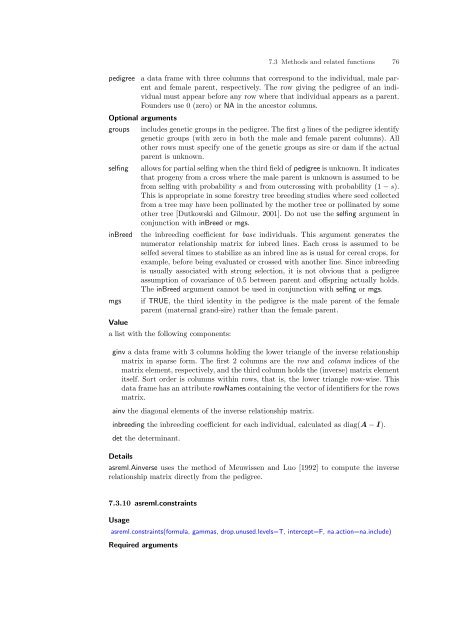ASReml-S reference manual - VSN International
ASReml-S reference manual - VSN International
ASReml-S reference manual - VSN International
- No tags were found...
Create successful ePaper yourself
Turn your PDF publications into a flip-book with our unique Google optimized e-Paper software.
pedigree7.3 Methods and related functions 76a data frame with three columns that correspond to the individual, male parentand female parent, respectively. The row giving the pedigree of an individualmust appear before any row where that individual appears as a parent.Founders use 0 (zero) or NA in the ancestor columns.Optional argumentsgroupsselfinginBreedmgsValueincludes genetic groups in the pedigree. The first g lines of the pedigree identifygenetic groups (with zero in both the male and female parent columns). Allother rows must specify one of the genetic groups as sire or dam if the actualparent is unknown.allows for partial selfing when the third field of pedigree is unknown. It indicatesthat progeny from a cross where the male parent is unknown is assumed to befrom selfing with probability s and from outcrossing with probability (1 − s).This is appropriate in some forestry tree breeding studies where seed collectedfrom a tree may have been pollinated by the mother tree or pollinated by someother tree [Dutkowski and Gilmour, 2001]. Do not use the selfing argument inconjunction with inBreed or mgs.the inbreeding coefficient for base individuals. This argument generates thenumerator relationship matrix for inbred lines. Each cross is assumed to beselfed several times to stabilize as an inbred line as is usual for cereal crops, forexample, before being evaluated or crossed with another line. Since inbreedingis usually associated with strong selection, it is not obvious that a pedigreeassumption of covariance of 0.5 between parent and offspring actually holds.The inBreed argument cannot be used in conjunction with selfing or mgs.if TRUE, the third identity in the pedigree is the male parent of the femaleparent (maternal grand-sire) rather than the female parent.a list with the following components:ginv a data frame with 3 columns holding the lower triangle of the inverse relationshipmatrix in sparse form. The first 2 columns are the row and column indices of thematrix element, respectively, and the third column holds the (inverse) matrix elementitself. Sort order is columns within rows, that is, the lower triangle row-wise. Thisdata frame has an attribute rowNames containing the vector of identifiers for the rowsmatrix.ainv the diagonal elements of the inverse relationship matrix.inbreeding the inbreeding coefficient for each individual, calculated as diag(A − I).det the determinant.Detailsasreml.Ainverse uses the method of Meuwissen and Luo [1992] to compute the inverserelationship matrix directly from the pedigree.7.3.10 asreml.constraintsUsageasreml.constraints(formula, gammas, drop.unused.levels=T, intercept=F, na.action=na.include)Required arguments
















